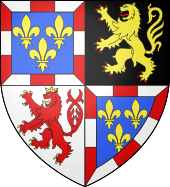Philipp (Brabant)
Philip of Saint-Pol (* July 25, 1404 , † August 4, 1430 in Leuven ) was Count of Saint-Pol and Ligny (1415-1430) and on April 17, 1427 Duke of Brabant and Limburg . He was the second son of Duke Anton von Brabant and Limburg from the House of Valois-Burgundy and Johanna von Luxemburg-Saint-Pol. His older brother was Johann von Brabant .
Live and act
In 1417 he fought at the side of his uncle Johann Ohnefurcht , the Duke of Burgundy , against the Armagnacs , and in 1419, after the capture of Paris, he was appointed Capitaine de Paris , the military governor of the city, at the age of only 15 . In 1425 he took part in the dispute between his brother, Duke John IV of Brabant and Limburg, and his former wife Jakobäa , the Countess of Hainaut and Holland .
While preparing to travel to the Holy Land , his brother died, leaving him the duchies of Brabant and Limburg. He intended to marry Jolante von Anjou, daughter of Ludwig II , Duke of Anjou , and Jolante von Aragon, but died before the wedding at the age of 26. Since he had no legitimate heirs, his cousin Philip the Good succeeded him as Duke of Brabant and Limburg. The counties of Ligny and Saint-Pol fell to his mother, who passed them on to her nephews Peter I of Luxembourg and John II of Luxembourg .
family
Philip of Saint-Pol had five illegitimate children with Barbara Fierens:
- Anton († 1498 in Hemixhem ), bastard of Brabant
- Philipp († 1465), Baron von Cruybeke , ⚭ 1463 Anne de Baenst († 1485)
- Johann († 1495), bastard of Brabant, bishop of Soissons
- Wilhelm, bastard of Brabant
- Isabella, Bastard of Brabant, ⚭ Philippe de Vieville
Individual evidence
- ^ Johann Samuelersch, Johann Georg Heinrich Hassel, Johann Gottfried Gruber, Wilhelm Müller, Andreas Gottlieb Hoffmann, August Leskien: General Encyclopedia of Sciences and Arts in alphabetical order. Second section: H – N. Gleditsch, 1842, p. 406. ( books.google.com ).
- ^ Paul Bonenfant, A.-M. Bonenfant-Feytmans: Philippe le Bon. Sa politique, son action. De Boeck, Paris / Bruxelles 1996, ISBN 2-8041-2115-1 , p. 113. ( books.google.de )
- ↑ Otto Julius Bernhard von Corvin-Wiersbitzki: Brief outline of the history of the Netherlands up to Philip the Second, together with a description of the country in 1560. 1841, p. 224. ( books.google.com )
- ^ Gisela Meyer: The Palant Family in the Middle Ages (= publications of the Max Planck Institute for History. Volume 202. ISSN 0436-1180 ). Vandenhoeck & Ruprecht, Göttingen 2004, ISBN 3-525-35852-0 , p. 311. ( books.google.de )
- ↑ Family tree. on racineshistoire.free.fr (PDF, p. 8.)
| predecessor | Office | successor |
|---|---|---|
| Johann IV. |
Duke of Brabant and Lothier Duke of Limburg Margrave of Antwerp 1427–1430 |
Philip the good |
| Walram III. |
Count of Ligny Count of Saint-Pol 1415–1430 |
Johanna |
| personal data | |
|---|---|
| SURNAME | Philip |
| ALTERNATIVE NAMES | Philip of Saint-Pol (full name) |
| BRIEF DESCRIPTION | Count of Saint-Pol and Ligny, Duke of Brabant, Duke of Limburg |
| DATE OF BIRTH | July 25, 1404 |
| DATE OF DEATH | 4th August 1430 |
| Place of death | Lions |

